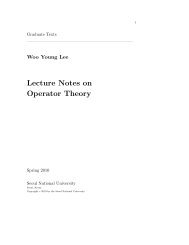A Polynomial Time Algorithm for the Braid Diffie-Hellman Conjugacy ...
A Polynomial Time Algorithm for the Braid Diffie-Hellman Conjugacy ...
A Polynomial Time Algorithm for the Braid Diffie-Hellman Conjugacy ...
Create successful ePaper yourself
Turn your PDF publications into a flip-book with our unique Google optimized e-Paper software.
A <strong>Polynomial</strong> <strong>Time</strong> <strong>Algorithm</strong> 215<br />
uniquely, x = ∆ k x ′ where x ′ is in B + n − ∆B + n . This is called <strong>the</strong> normal <strong>for</strong>m of<br />
x.<br />
There is a partial order on B + n : x ≤ y ⇔ y ∈ xB + n . The ordering is inherited<br />
to S n (We identify a permutation σ with <strong>the</strong> corresponding braid rσ in B + n .).<br />
We denote rS n by Ω <strong>for</strong> simplicity reason. For a braid x ∈ B + n , <strong>the</strong> greatest<br />
element of <strong>the</strong> set {y ∈ Ω|y ≤ x} is called <strong>the</strong> left most factor of x and denoted<br />
by LF(x). A sequence of braids (x 1 ,... ,x k )inΩ −{1} is called <strong>the</strong> greedy <strong>for</strong>m<br />
of x if x 1 ···x k = x, LF(x i x i+1 )=x i <strong>for</strong> all i. The above k in <strong>the</strong> greedy <strong>for</strong>m<br />
is called <strong>the</strong> Charney length of x. This length function is easily extended to<br />
general braids using Thurston normal <strong>for</strong>m, but we don’t need it so general <strong>for</strong><br />
our purpose and we will omit <strong>the</strong> general definition.<br />
2.2 <strong>Braid</strong> Cryptography<br />
Let G be a non-abelian group and u, a, b, c ∈ G. In order to per<strong>for</strong>m <strong>the</strong> <strong>Diffie</strong>-<br />
<strong>Hellman</strong> key agreement on G we need to choose a, b in G satisfying ab = ba in<br />
<strong>the</strong> DHCP. Hence we introduce two commuting subgroups G 1 ,G 2 ⊂ G satisfying<br />
ab = ba <strong>for</strong> any a ∈ G 1 and b ∈ G 2 . More precisely, <strong>the</strong> problems <strong>the</strong> braid<br />
cryptography are based on are as follows:<br />
– Input: A non-abelian group G, two commuting subgroups G 1 ,G 2 ⊂ G<br />
– <strong>Conjugacy</strong> Problem (CP): Given (u, aua −1 ) with u, a ∈ G, compute a. (Note<br />
that if we denote aua −1 by u a , it looks like <strong>the</strong> DLP.)<br />
– <strong>Diffie</strong>-<strong>Hellman</strong> <strong>Conjugacy</strong> Problem (DHCP): Given (u, aua −1 , bub −1 ) with<br />
u ∈ G, a ∈ G 1 and b ∈ G 2 , compute baua −1 b −1 .<br />
– Decisional <strong>Diffie</strong>-<strong>Hellman</strong> <strong>Conjugacy</strong> Problem (DDHCP): Given<br />
(u, aua −1 , bub −1 , cuc −1 ) with u, c ∈ G, a ∈ G 1 and b ∈ G 2 , decide<br />
whe<strong>the</strong>r abub −1 a −1 = cuc −1 .<br />
In braids, we can easily take two commuting subgroups G 1 and G 2 of B n<br />
(For simplicity, we only consider a braid group with an even braid index. But it<br />
is easy to extend this to an odd braid index.). For example, G 1 = LB n (resp.<br />
G 2 = RB n ) is <strong>the</strong> subgroup of B n consisting of braids made by braiding left<br />
n/2 strands(resp. right n/2 strands) among n strands. Thus LB n is generated<br />
by σ 1 ,... ,σ n/2−1 and RB n is generated by σ n/2+1 ,... ,σ n−1 . Then we have <strong>the</strong><br />
commutative property that <strong>for</strong> any a ∈ G 1 and b ∈ G 2 , ab = ba.<br />
[Key agreement.] This is <strong>the</strong> braid group version of <strong>the</strong> <strong>Diffie</strong>-<strong>Hellman</strong> key<br />
agreement.<br />
1. Initial setup: (a) Choose system parameters n and l from positive integers.<br />
(b) Select a sufficiently complicated positive braid u ∈ B n with l canonical<br />
factors.<br />
2. Key agreement: Per<strong>for</strong>m <strong>the</strong> following steps each time a shared key is<br />
required.<br />
(a) A chooses a random secret positive braid a ∈ LB n with l canonical













